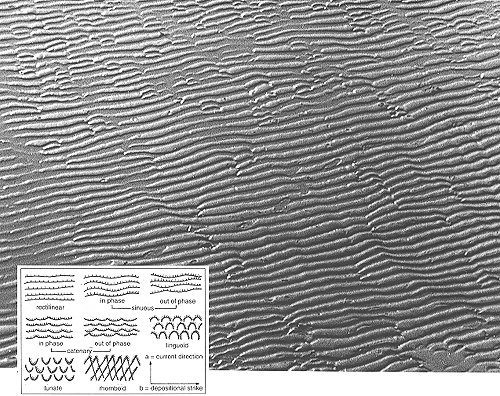
Bed forms: linear ripples
Plate 31

Bed forms: linear ripples
Plate 31
Rectilinear ripples have a good lateral continuity and parallelism, and are not usually associated with larger forms. They can be produced by both waves (as in the case illustrated here) and currents that are almost bidimensional, in the hydraulic sense. The flow lines develop secondary eddies near the bottom that are markedly cylindrical (rolls), and dovetail at their ends with similar neighbors creating the junctions you see in the picture.
The flat sandy bottom is that of a subaqueous beach exposed at low tide along the Adriatic shoreline. The ripples have flattened crests; they were formed and modified by waves in shallow water. A fossil analog (apart from the flattening) can be found in plate 45 for comparison.
Subaqueous ripples and dunes are equilibrium forms, as said before. When the physical conditions change, these forms become unstable and change into others or are canceled to fit the new conditions. However, they can have some inertia, or resistance to change, which depends on time or other factors. If the current velocity and the water depth on a dune-covered bed are slowly reduced, for example, dunes are actually smoothed out and replaced by ripples. Ripples, however, do not disappear even when the current has completely waned. Dunes can survive, as shown by plates 28 and 29, if the current decelerates and/or the water drains away in a relatively short time. As for the ripples, there is no problem of time: they persist in any case. One may thus conclude that ripples have the maximum preservation potential among bed forms; consequently, it is no surprise that they constitute one of the most common structure found in sedimentary rocks, considering also that weak currents are sufficient to form them, and that some sort of current can exist at any depth in any aqueous environment.
Bed forms not wholly effaced by changing conditions are altered or modified. Modified structures can be defined as the remnants of original structures, modification structures as the overprinted ones.
| Photo: G. Piacentini 1970. |